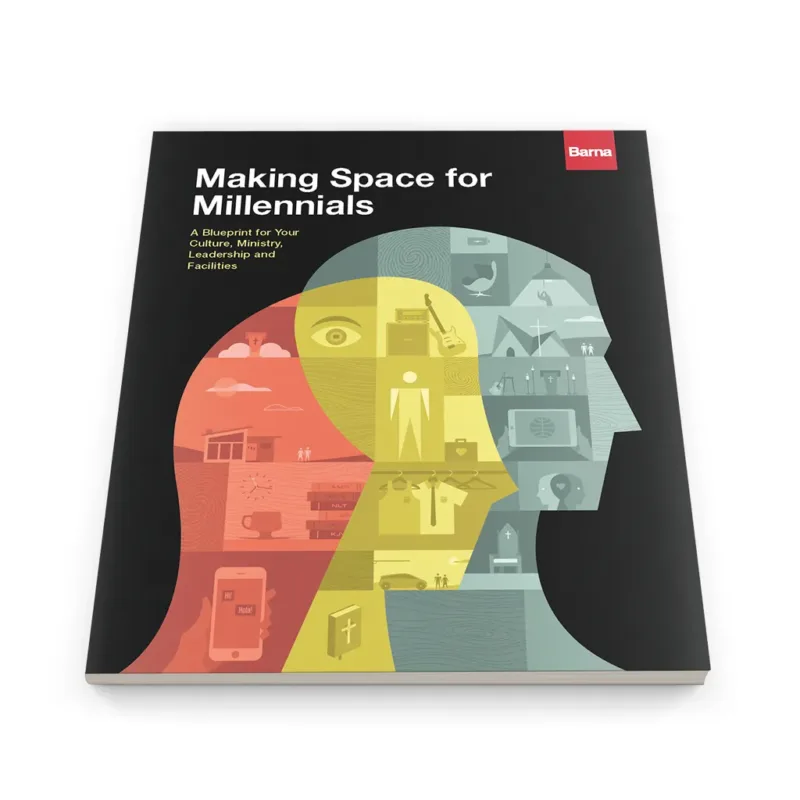
Like it or not—and there are plenty of reasons not to—consumer culture shapes what people expect of church and how some churches approach ministry.
It’s tempting to think of church as one part of the “religious services industry”—the sector of the economy that provides spiritual goods and experiences to consumers. When leaders conceive of their faith community this way, even unconsciously, they see their difficulty appealing to Millennials as a failure to create brand loyalty—a failure whose solution is a better product and/or better marketing. To be successful in the industry, churches have to compete in a marketplace undergoing massive disruption as a generation of young consumers becomes ever more knowledgeable and selective about what they do and don’t want.
If the church were just another business seeking market share, this frame of mind would be harmless or even beneficial. But the church is not. And many of the very people churches are trying to reach—Millennials—are hyperaware and deeply suspicious of the intersection of church and consumer culture. This doesn’t mean they’re not avid consumers, for most certainly are. But many also have a sense that church should be different somehow, above or beyond the dirty business of sell, sell, sell.
So what do Millennials think of church? What pushes them away and what draws them in? And when they do visit a church, how are they hoping to be approached?
Making Space for Millennials
A blueprint for your culture, ministry, leadership and facilities
Closed Doors
Why have so many Millennials closed the door on church involvement? Why, even among those who grew up in church, have nearly six in ten dropped out at some point? Why have more than half been absent from church for the past six months? Why do three in ten Millennials say church is not at all important while an additional four in ten feel ambivalent, saying church is either somewhat important or somewhat not important?
During the research for Sacred Roots, a book in the Barna FRAMES series, Barna asked Millennials why they do or don’t think church is important. Their answers reveal a general feeling that church is simply not necessary—and, for some, that it is harmful.
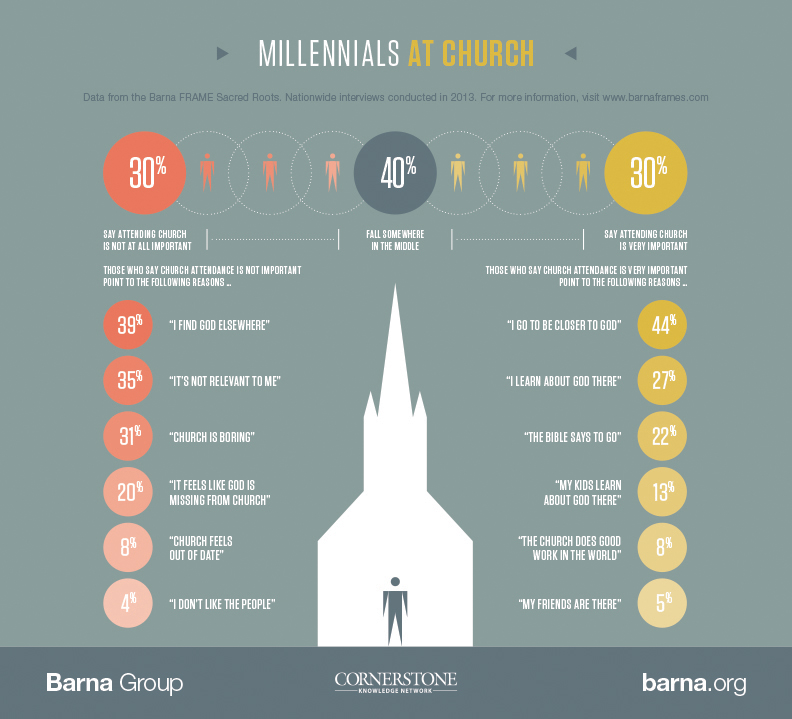
Among those who say church is not important, most are split between two reasons: two in five say church is not important because they can find God elsewhere (39%), and one-third say it’s because church is not personally relevant to them (35%). One in three simply find church boring (31%) and one in five say it feels like God is missing from church (20%). Only 8% say they don’t attend because church is “out of date,” undercutting the notion that all churches need to do for Millennials is to make worship “cooler.”
A significant number of young adults have deeper complaints about church. More than one-third say their negative perceptions are a result of moral failures in church leadership (35%). And substantial majorities of Millennials who don’t go to church say they see Christians as judgmental (87%), hypocritical (85%), anti-homosexual (91%) and insensitive to others (70%).
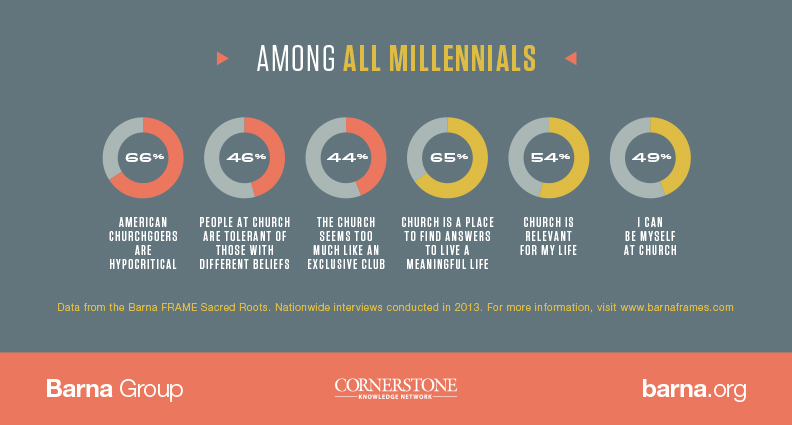
During a national, multi-phase research program among Millennials, conducted in partnership with Cornerstone Knowledge Network, participants were asked to rate how well each statement in a series describes the Christian community in America. Fewer than half of Millennials agree that the statement “The people at church are tolerant of those with different beliefs” describes the church (a lot + somewhat = 46%). About the same proportion say “The church seems too much like an exclusive club” is an accurate description (44%). Taken together, a significant number of young adults perceive a lack of relational generosity within the U.S. Christian community. Perhaps more concerning are the two-thirds of Millennials who believe that American churchgoers are a lot or somewhat hypocritical (66%). To a generation that prides itself on the ability to smell a fake at ten paces, hypocrisy is a worrisome indictment.
Making Space for Millennials
A blueprint for your culture, ministry, leadership and facilities
These negative perceptions are not limited to word descriptions. One phase of the Barna/CKN research program included visual polling, and when asked to select the image that best represents “present-day Christianity,” Millennials show the same basic pattern.

A majority—from all faith backgrounds, including Christianity—chose one of the two negative images. More than one-third chose the pointing finger (37%), and another one in six chose the bullhorn-wielding protestor (16%). In total, 52% of respondents view present-day Christianity as aggressive and critical.
But the perceptions are not all negative. About one in four chose the crowd of worshippers (23%). Some may have chosen the worshippers because they see Christianity as vibrant and communal (among practicing Christians, 31% chose this picture), and others because they view Christianity as emotional and consumer-oriented. Either way, this illustration does not have the same negative resonance with Millennials as do the more hostile, judgmental images.
One in four chose the overtly positive image, the helping hand reaching out to a person in need (24%). It’s encouraging that a significant proportion of Millennials view Christianity this way. The percentage is even higher among practicing Christian young adults (34%), indicating that those who are engaged in a local church want to live out a faith that is actively reaching into the community.
Open Windows
If those are the closed doors of negative views on the church, positive perceptions are windows that show Millennials’ openness to connecting with the Jesus community. What do they find valuable in church? Their answers can provide insight for what to prioritize in ministry to and with Millennials.
A plurality say they attend church to be closer to God (44%) and more than one-third say they go to learn more about God (37%). Getting outside the humdrum of their everyday lives to experience transcendence—in worship, in prayer, in teaching—is a key desire for many Millennials when it comes to church.
Two-thirds of survey participants say a good description of church is “a place to find answers to live a meaningful life” (a lot + somewhat = 65%). Over half say “church is relevant for my life” (54%), and about half “feel I can ‘be myself’ at church” (49%). Three out of five survey respondents don’t agree that “the faith and teaching I encounter at church seem rather shallow” (not too much + not at all = 62%), and about the same number don’t believe “the church is not a safe place to express doubts” (60%).
That’s a lot of open windows.
We asked Millennials to select an aspirational image for what church should be in the world and found that, by and large, young adults respect the potential of organized religion. Almost half chose the image of a small-group Bible study (48%), which combines the social and intellectual aspects of Christianity. Most of the rest chose the image of a growing flower (33%), which implies a possibility for personal growth and for cultivating beauty (and . . . nature again!). The other two images—the hospital and the health club—were much less popular (12% and 7%, respectively).
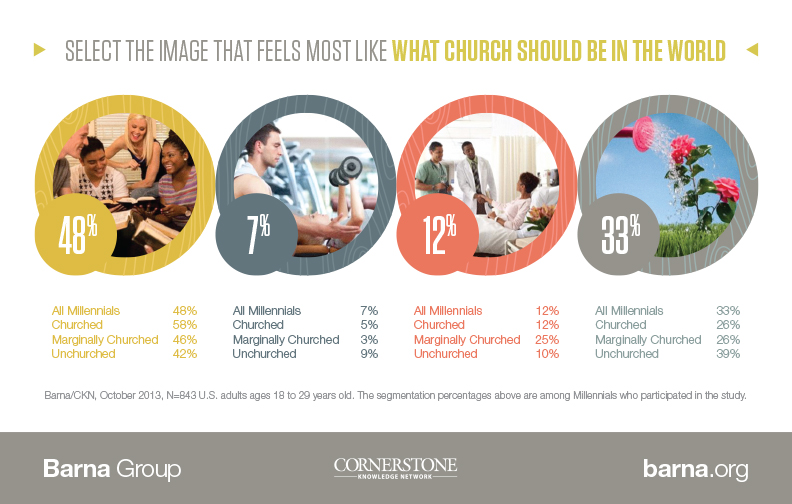
Millennials are skeptical about the role churches play in society. This is the closed door. But their hope for the role churches could play? That’s an open window.
So what happens when a Millennial does come in through an open window? How should churches respond to their Millennial guests?
Making Space for Millennials
A blueprint for your culture, ministry, leadership and facilities
The Visiting Millennial
In the Barna/CKN national survey, Millennials were asked what information they would be willing to give a church when they visit. (Remember, with fewer than half of Millennials having attended church in the past six months, it’s fair to say that if and when they go to church, it’s often as an outsider. Even those who are not strangers to church may feel like outsiders if it has been awhile since they attended.)
The only piece of information a sizeable majority of Millennials is comfortable sharing with a church is their first name (82%). Only half are willing to give their last names (53%). Just one-third are comfortable sharing their email address (33%). That means two out of three young-adult visitors do not want churches to have that information.
Only one in five Millennials are comfortable handing over their physical address (19%), and even fewer their phone number (12%). A mere 6% are willing to grant access on social media, such as friending on Facebook or following on Twitter or Instagram.
About one in six Millennials would rather not share anything (15%). Among non-Christian young adults, it’s more than one in four (28%).
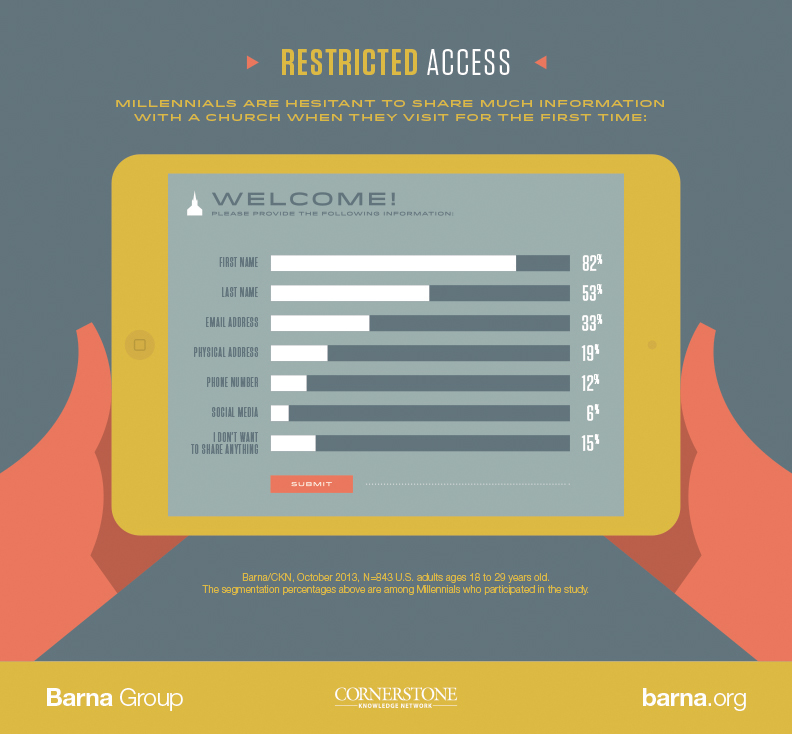
Millennials are generally not restrictive of their personal information and privacy, but they tend to distrust churches. In fact, according to research Barna conducted for the FRAMES series, Millennials are the least likely generation to say the church has their best interests at heart (30%, compared to 34% of Gen-Xers and 41% of Boomers and Elders). This is one reason they prefer to stay off the radar until they are comfortable at church.
What the Research Means
“Ignoring visitors is not the solution, but consider how your church could defer social status to your guests,” says Clint Jenkin, VP of Research at Barna Group and the lead developer and analyst on the study. “When Millennials visit your faith community, are they welcomed and respected, or harassed and put on the spot? Think about how you can respect and respond, rather than assert and demand. Perhaps a smile and a nod or wave from a greeter, rather than a handshake. Maybe a clearly marked welcome kiosk instead of someone intercepting them the minute they set foot in the door. The leader who welcomes everyone to the worship service could communicate where, how and from whom to get more information, putting your guest in the driver’s seat, socially speaking.
“If, at the end of the day, teens and adults can say they met with God in your faith community, getting them to come back won’t be much of an issue,” Jenkin continues. “The fact remains that eight out of 10 young adults say growing closer to or learning about God are the two most important reasons to attend church. And with all the other options open to Millennials, it’s safe to conclude that, when they show up at church for a worship or learning opportunity, they do so hoping there is Someone present to worship or learn about.”
Comment on this research and follow our work:
Twitter: @davidkinnaman | @roxyleestone | @barnagroup
Facebook: Barna Group
About the Research
The Barna/CKN Millennials and Architecture survey included 843 online surveys conducted among adult residents of the United States ages 18 to 29. The survey was conducted from October 10 through October 15, 2013. The margin of error for a sample of this size is plus or minus 5.2 percentage points, at the 95% confidence level.
This study used an online research panel called KnowledgePanel® based on probability sampling that covers both the online and offline populations in the U.S. The panel members are randomly recruited by telephone and by self-administered mail and web surveys. Households are provided with access to the Internet and hardware if needed. Unlike other Internet research that covers only individuals with Internet access who volunteer for research, this process uses a dual sampling frame that includes both listed and unlisted phone numbers, telephone and non-telephone households and cell-phone-only households. The panel is not limited to current Web users or computer owners. All potential panelists are randomly selected to join the KnowledgePanel; unselected volunteers are not able to join.
The response rate for this study was 38%. Email reminders were sent out to non-responders on day three of the fielding period. In every survey there are a variety of ways in which the accuracy of the data may be affected. The response rate is one such potential cause of error in measurement; the lower the response, the less representative the respondents surveyed may be of the population from which they were drawn, thereby reducing the accuracy of the results. Other sources of error include question-design bias, question-order bias, sampling error and respondent deception. Many of these types of errors cannot be accurately estimated. However, having a high cooperation rate does enhance the reliability of the information procured.
Minimal statistical weighting was used to calibrate the sample to known population percentages in relation to demographic variables.
The research was jointly commissioned by Aspen Group (as part of a collaboration called Cornerstone Knowledge Network) and Barna Group.
© Barna Group, 2015.
About Barna
Since 1984, Barna Group has conducted more than two million interviews over the course of thousands of studies and has become a go-to source for insights about faith, culture, leadership, vocation and generations. Barna is a private, non-partisan, for-profit organization.
Related Posts

Why Millennials Aren’t Watching Your Streamed Worship Services
- Generations
- Leadership

Christian Millennials Are Most Likely Generation to Lean Toward Charismatic Worship
- Faith
- Generations
-
From the Archives

Almost Half of Practicing Christian Millennials Say Evangelism Is Wrong
- Generations
-
From the Archives

5 Reasons Millennials Stay Connected to Church
- Generations
-
From the Archives

Only One-Third of Young Adults Feels Cared for by Others
- Generations
-
From the Archives
Get Barna in Your Inbox
Subscribe to Barna’s free newsletters for the latest data and insights to navigate today’s most complex issues.




